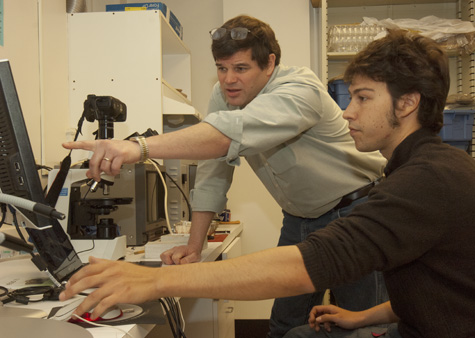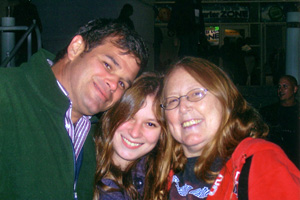Humans today struggle with environmental problems such as a depleted ozone layer, global warming and too much mercury in oceans — influences of humans on the environment that put our own existence at risk.
But humans altering their environment with disastrous results is nothing new. Just ask archaeologist T.R. Kidder, PhD, who has spent the past four summers excavating the Han Dynasty village of Sanyangzhuang in central China.

Sanyangzhuang was buried by silt when the town was flooded 2,000 years ago, leaving a nearly perfectly preserved example of an ancient Chinese farming village, complete with tools, grinding stones and remains of looms. It’s a Chinese “Pompeii” — only this disaster was more of an act of politics than an act of nature, says Kidder, professor and chair of anthropology in Arts & Sciences.As the Han government sent people to grow food and cultivate the easily eroded soil near the beginning of China’s Yellow River, more sediment flowed downstream. At the same time, large levees were built along the river to prevent flooding of farmland. As sediment built up at the river bottom, it raised the river above the floodplain until it was too high for the levees to contain. The result: catastrophic flooding for villages like Sanyangzhuang.
“The flood wasn’t random,” says Kidder, also professor of environmental studies in Arts & Sciences. “It happened because the Han people changed the environment.”
Sanyangzhuang lay entombed in silt for nearly 20 centuries until a Chinese construction crew discovered it trying to dig an irrigation ditch. Kidder, an archaeologist with experience excavating Native American sites in the Southeastern United States, was invited by a Chinese colleague to join the archaeological team.
Excavation of Sanyangzhuang “gives us a glimpse of rural China,” Kidder says.
“Other than the sort of general textual statements in historical documents, we know little of what it was like to live in Han China on a day-to-day basis that doesn’t come from a biased record,” he says.
Archaeologists are learning more, thanks to work by Kidder, says Michael Frachetti, PhD, associate professor of anthropology, whose research focuses on pastoral nomadic societies in Central and Eastern Eurasia.
“Although he will tell you he is still new to Chinese archaeology, T.R. has established himself as a player in the field of East Asian archaeology,” Frachetti says. “His novel use of geoarchaeology in China opens new doors for analyzing ancient Chinese history, and our colleagues there are increasingly interested in the new environmental and social history that scholars like T.R. are exposing.”
T.R. Kidder, professor of anthropology, discusses his family history with archaeology and discovering connections to people of the past.
Black sheep
Kidder was born in Kobe, Japan, while his father worked as a diplomat at the U.S. Consulate in Osaka. His family moved back to the United States three years later, and, after a brief stop in Ohio, Kidder grew up in New England.
As a boy, Kidder says he always had an interest in history and spent a lot of time reading history books, from military history to Time Life books on historical epochs. When those ran out, he moved onto whatever was lying around. “I was one of those nerdy kids that read the encyclopedia,” he says.
When it came to college, Kidder applied to the family school, Harvard University in Cambridge, Mass., and to the “exotic” Tulane University in New Orleans, among others. After a thin envelope arrived from Harvard, Kidder decided he was bound for the Big Easy. And, in retrospect, Kidder says, it was a great decision.
“My father’s side and mother’s side is Crimson through and through, so I was truly a black sheep when I didn’t get into Harvard as an undergraduate,” Kidder says. “But getting out of New England was a good thing. I think one of the most important things that can happen during that age is to go to different places, see different things and experience different cultures. New Orleans was a different world.”
Life among alligators
Before leaving for Tulane, Kidder’s grandmother sent him a book on archaeology written by his grandfather. Despite the nudge, Kidder, a third-generation archaeologist, didn’t earnestly consider pursuing archaeology until a field school course between his sophomore and junior years at Tulane.
“I had decided to do a one-man ethnography of bars of New Orleans during my sophomore year, and I had to take a summer school course to remediate myself,” Kidder says.
“I had an epiphany, to the extent that at age 19 you can have an epiphany. It was a hot sunny day in southwestern Louisiana, and it seemed like it was 900 degrees. Spanish moss. Alligators. Cajuns going by. And there we were, excavating a Native American village site dating from 1200 AD to European contact. I really enjoyed it. Not only was it a lot of fun, but it was intellectually interesting.”

Kidder majored in anthropology at Tulane and applied to Harvard University’s Lower Mississippi Survey program — the premier place to study southeastern archaeology — for graduate school. This time, the black sheep was accepted.
After earning a doctorate in anthropology at Harvard in 1988 — his dissertation examined how Native Americans in the lower Mississippi Valley responded to changes brought about by the beginning of European contact — Kidder returned to his alma mater, Tulane, as assistant professor of anthropology in 1989.
Kidder continued his excavation work in Louisiana and was named associate professor in 1995 and professor in 2003.
That same year, Kidder came to WUSTL as professor. But he didn’t leave New Orleans behind completely. After Hurricane Katrina ravaged the city and surrounding areas in August 2005, Kidder and Stephen Gibson, PhD, lecturer in American Culture Studies in Arts & Sciences, co-taught a course on Katrina, “A Case Study in Disaster Relief,” during the spring 2006 semester.
The class included a spring-break service trip to St. Bernard Parish near New Orleans. There, students — along with Kidder and Gibson — served meals and salvaged buildings during the day and camped in tents at night.
“We created this class to help our students grapple not only with the event itself but its social, history, political and economic context,” Kidder says. “But we didn’t want the course to be wholly an academic exercise.
“It’s one thing to talk about the politics of flooding, and it’s another thing to talk to 89-year-old man who is sobbing because his home was flooded by a wall of water. No amount of teaching could bring that experience home. New Orleans, St. Bernard, it was something that one had to see to understand.”
Connecting with people
As chair of the anthropology department, Kidder focuses his attention on faculty and students as well as Native American sites and buried Chinese villages.
“T.R. excels at balancing the complex needs of a large department with the individual concerns of each faculty member,” Frachetti says. “Perhaps because he’s an archaeologist, T.R. pairs a keen analysis of current issues with a historical perspective — which means also thinking about the impact of today’s decisions in the future.
“He is open to revision and input from all sources, which enables everyone to feel real investment in the directions we are moving.”
Ling-yu Hung, PhD, assistant professor of anthropology at Indiana University Bloomington and a former WUSTL graduate student, says Kidder’s support during her dissertation and job-hunting experience helped her further her academic career.
“When I was writing my dissertation, he offered to have a meeting with me every week. He really read every draft of my dissertation and spent a lot of time discussing with me about my arguments and ideas,” Hung says.
Above all, it’s the connections with people — living and dead — that fascinate Kidder.
“While digging in China, I got to excavate some footprints,” Kidder says. “I could make out the bare feet, and the lifelines at the bottom of the feet. This was someone from 400 BC. I realized, ‘Wow, I’m touching a human being from 2,500 years ago.’
“It was just amazing.”
Fast facts about T.R. Kidder
Education: BA, anthropology, 1982, Tulane University; MA, 1987, PhD, 1988, anthropology, Harvard University.
Born in: Kobe, Japan
Family: Wife, Eileen; daughter, Erin; two cats and a dog
Lives in: Crystal Lake Park, Mo., a four-block by four-block suburb of St. Louis between Frontenac, Town & Country and Des Peres
T.R. stands for: Tristram Randolph